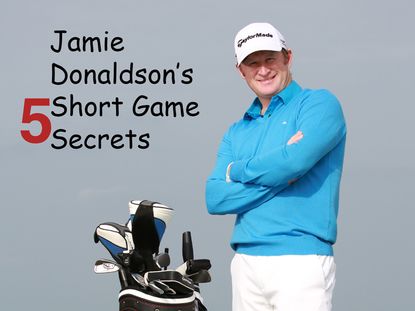Jamie Donaldson's 5 Short Game Secrets


A good short game is what turns a good score into a great one. Jamie Donaldson's 5 short game secrets could help you transform yours!
1 Know Your Game
Over the last year or so, with Rory McIlroy performning so well and hitting it so far, a lot has been said about the importance of power in the modern game. But the reality is, you can’t worry about what anyone else is doing and how they are playing. Rory’s has a power game because that’s the way he does it. You have to play to your own strengths, whatever they may be. But regardless of whether you can hit the ball a long way or your pitching is a real strength or your fairway wood play is solid, one thing is important for all of us – the short game. This is vital because when you’re not playing very well, this is what turns an average day into a good one.
2 Short Game Practice
A typical short game practice session for me involves going around the green in different positions with three balls, playing to different flags. The point here is that every position I go to gives me a different shot to play. I don’t just stand there with a lot of balls chipping to the same hole, practicing the same shot and the same technique over and over again. By changing your position it forces you to constantly adapt and adjust your approach, which is exactly what you need on the course. Sometimes you need to stop the ball faster so you go a bit higher, and vice versa. This gives you a really good feel for the different techniques required in the short game.
Obviously, we play on courses all over the world with different grasses that require you to hit different short game shots. I would say the same applies if you play regularly away from your home club – you have to adapt to the different ground conditions. Sometimes you hit your short game shots a little harder and others softer. Sometimes it’s more of a bunker shot that’s required, sometimes you just need to smash itÖ Sometimes you just don’t have a clue!
Get the Golf Monthly Newsletter
Subscribe to the Golf Monthly newsletter to stay up to date with all the latest tour news, equipment news, reviews, head-to-heads and buyer’s guides from our team of experienced experts.
3 Improving your short game
Getting a better short game is all about practice, but one simple piece of advice I would offer is the faster you can get the ball on the ground running, the better. It’s harder to fly the ball the whole way there and get it to stop, as you need to make perfect contact every time. For amateurs, the quicker you can get it on the ground running, the better – the more margin for error you have on the strike and the results will be more consistent. Also, don’t be afraid to get the putter out 10 yards away from the green, especially in the winter when it’s damp and wet underfoot and difficult to get a consistent strike. Ultimately, it’s about getting the ball in the hole in as few shots as possible and that’s the best way to do it.
4 My Putting Technique
I like to feel as though I’m pushing the putter head down the line of the putt, so I prefer a shorter backswing to get the ball rolling down the line a bit more. My fault is to get long in the backswing and decelerate into the ball. When I do that, the ball doesn’t start on line. So I like for the stroke to be a bit shorter and push the putter head through with a slightly longer through stroke – for me, that generally starts the ball on line.
5 Equipment choices
Your choice of golf ball is important. I play the ProV1x, which I think nowadays, can be used by sub 15-handicappers with no problem. Fifteen and above will probably need a firmer ball which releases more and goes further off the tee, but certainly in the summer, the ProV1x is pretty good for everyone. It’s not like the old days when amateurs would thin a pro ball and cut it in half! Pro balls are much more durable nowadays and a little firmer. I used to use the ProV1, but the ProV1X is now softer than it used to be, which suits me more. So that’s what I prefer to use.
I have three Titleist Vokey wedges in my bag - a 48˚pitching wedge, a 54˚ gap wedge and a 60˚lob wedge. There are six degrees between each wedge and that’s generally best for me both for pitching and giving me options around the green. I have 4˚ degrees on my lob wedge, which is quite low in comparison to what other players would have. I am able to use the bounce to help me if I need to, but I like to see the leading edge of the wedge sitting tight to the grass. The 54˚ is about 11˚ of bounce, and the 48˚ is about the same number. I’ve never been bothered about bounce on the 54˚. That’s just how it comes! But because the lob wedge has a thicker sole, it can sit quite high with a high bounce, whereas I prefer it to sit tight.
In The Bag
Driver: TaylorMade SLDR 460, 9.5˚
Fairway Woods: TaylorMade RocketBallz Tour, 14.5˚
Callaway Steel Head 5-wood
Irons: PING i15
Wedges: Tiyleist Vokey SM5 48˚, 54˚, 60˚
Ball: Titleist Pro V1X

In July 2023, Neil became just the 9th editor in Golf Monthly's 112-year history. Originally working with the best coaches in the UK to produce instruction content, he has also presented many Golf Monthly videos looking at all areas of the game from Tour player interviews to the rules of golf.
Throughout his time with the brand he has also covered equipment launches that date back well over a decade. He clearly remembers the launch of the Callaway and Nike square drivers as well as the white TaylorMade driver families, such as the RocketBallz! If you take a look at the Golf Monthly YouTube channel, you'll see his equipment videos dating back over a decade! He has also conducted 'What's In The Bag' interviews with many of the game's best players like Rory McIlroy, Dustin Johnson and Jon Rahm. Over the years, Neil has tested a vast array of products in each category and at drastically different price-points.
Neil is currently playing: Driver: TaylorMade Stealth Plus Fairway Wood: Titleist TSR2 Hybrid: Titleist TS3 Irons: PING Blueprint S (4&5), PING Blueprint T (6-PW) Wedges: Titleist Vokey SM7 50˚, 54˚, 60˚ Putter: Odyssey Triple Track Ten Ball: Titleist Pro V1X
-
 Zurich Classic Of New Orleans Prize Money Payout 2024
Zurich Classic Of New Orleans Prize Money Payout 2024Nick Hardy and Davis Riley defend their title at the team event as Rory McIlroy and Shane Lowry also play
By Mike Hall Published
-
 PGA Tour Players Set To Discover Quantitative Cost Of Loyalty As Equity Shares Handed Out This Week: Report
PGA Tour Players Set To Discover Quantitative Cost Of Loyalty As Equity Shares Handed Out This Week: ReportPlayers who didn't jump ship to LIV Golf will reportedly find out how much their loyalty was worth this week
By Joel Kulasingham Published